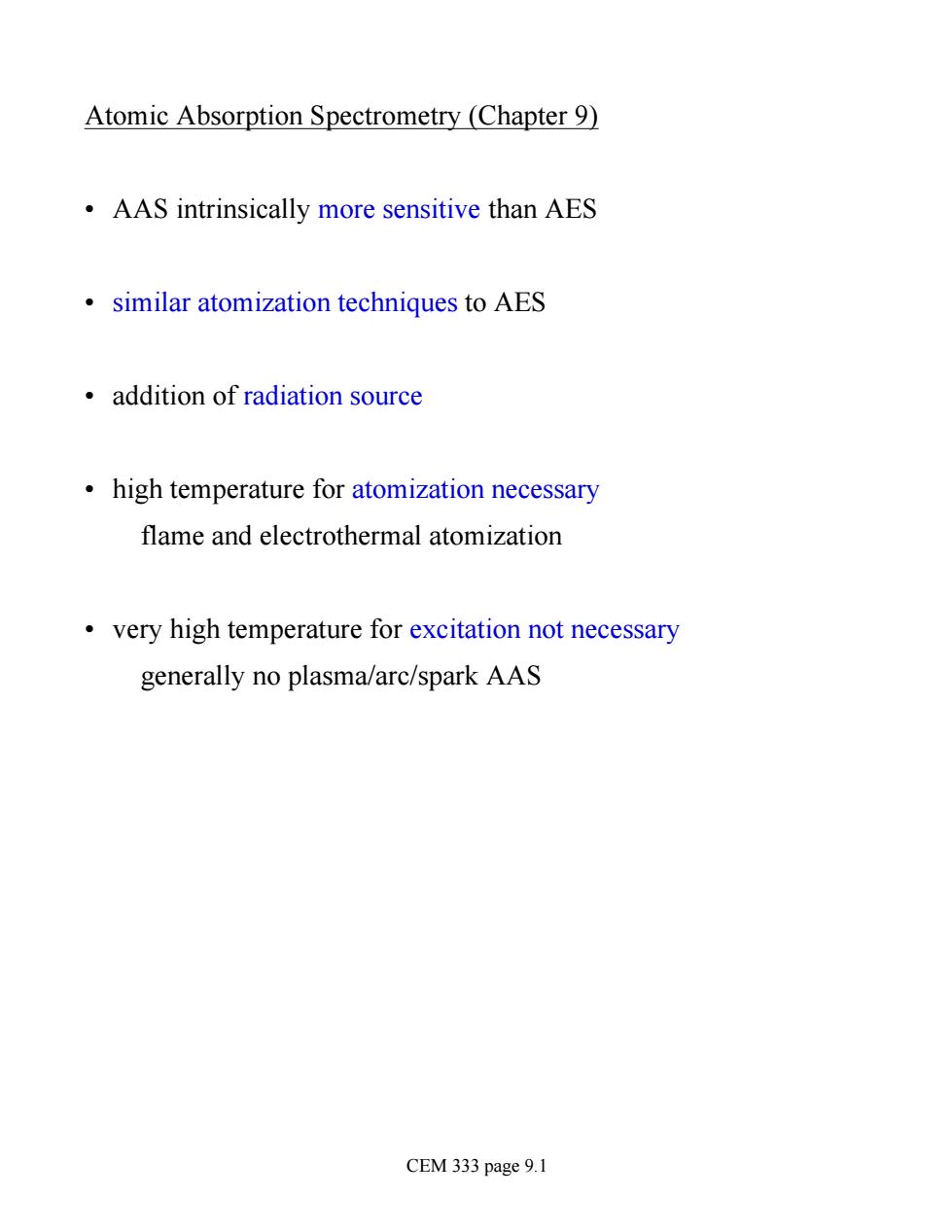
Atomic Absorption Spectrometry (Chapter 9) AAS intrinsically more sensitive than AES similar atomization techniques to AES addition of radiation source high temperature for atomization necessary flame and electrothermal atomization very high temperature for excitation not necessary generally no plasma/arc/spark AAS CEM 333 page 9.1
Atomic Absorption Spectrometry (Chapter 9) • AAS intrinsically more sensitive than AES • similar atomization techniques to AES • addition of radiation source • high temperature for atomization necessary flame and electrothermal atomization • very high temperature for excitation not necessary generally no plasma/arc/spark AAS CEM 333 page 9.1
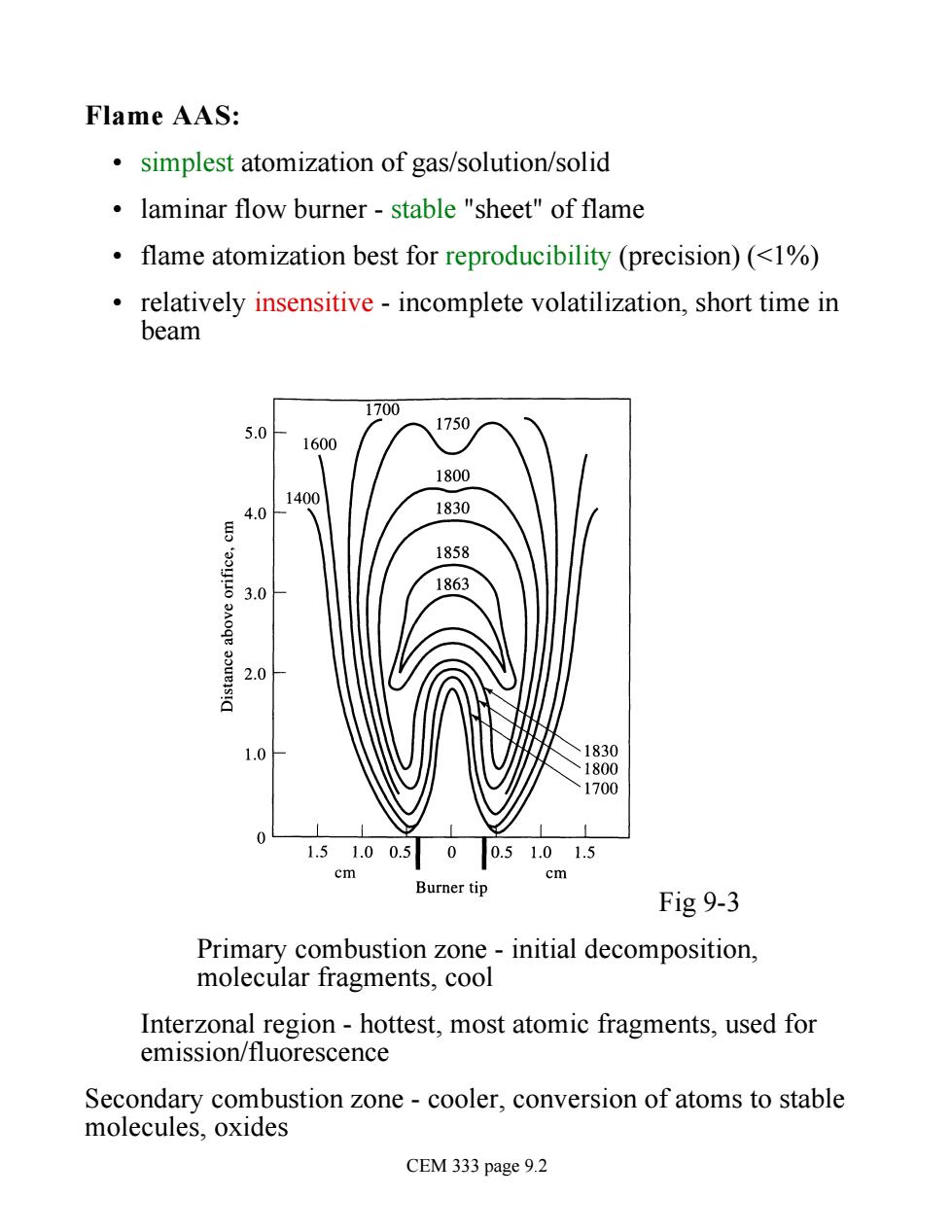
Flame AAS: simplest atomization of gas/solution/solid laminar flow burner-stable "sheet"of flame flame atomization best for reproducibility (precision)(<%) relatively insensitive-incomplete volatilization,short time in beam 700 5.0 1750 1600 1800 40 1830 1858 3.0 2.0 830 70 1.51.00.500.51.01.5 cm Burner tip Fig 9-3 Primary combustion zone-initial decomposition, molecular fragments,cool Interzonal region -hottest,most atomic fragments,used for emission/fluorescence Secondary combustion zone-cooler,conversion of atoms to stable molecules,oxides CEM 333 page 9.2
Flame AAS: • simplest atomization of gas/solution/solid • laminar flow burner - stable "sheet" of flame • flame atomization best for reproducibility (precision) (<1%) • relatively insensitive - incomplete volatilization, short time in beam Fig 9-3 Primary combustion zone - initial decomposition, molecular fragments, cool Interzonal region - hottest, most atomic fragments, used for emission/fluorescence Secondary combustion zone - cooler, conversion of atoms to stable molecules, oxides CEM 333 page 9.2
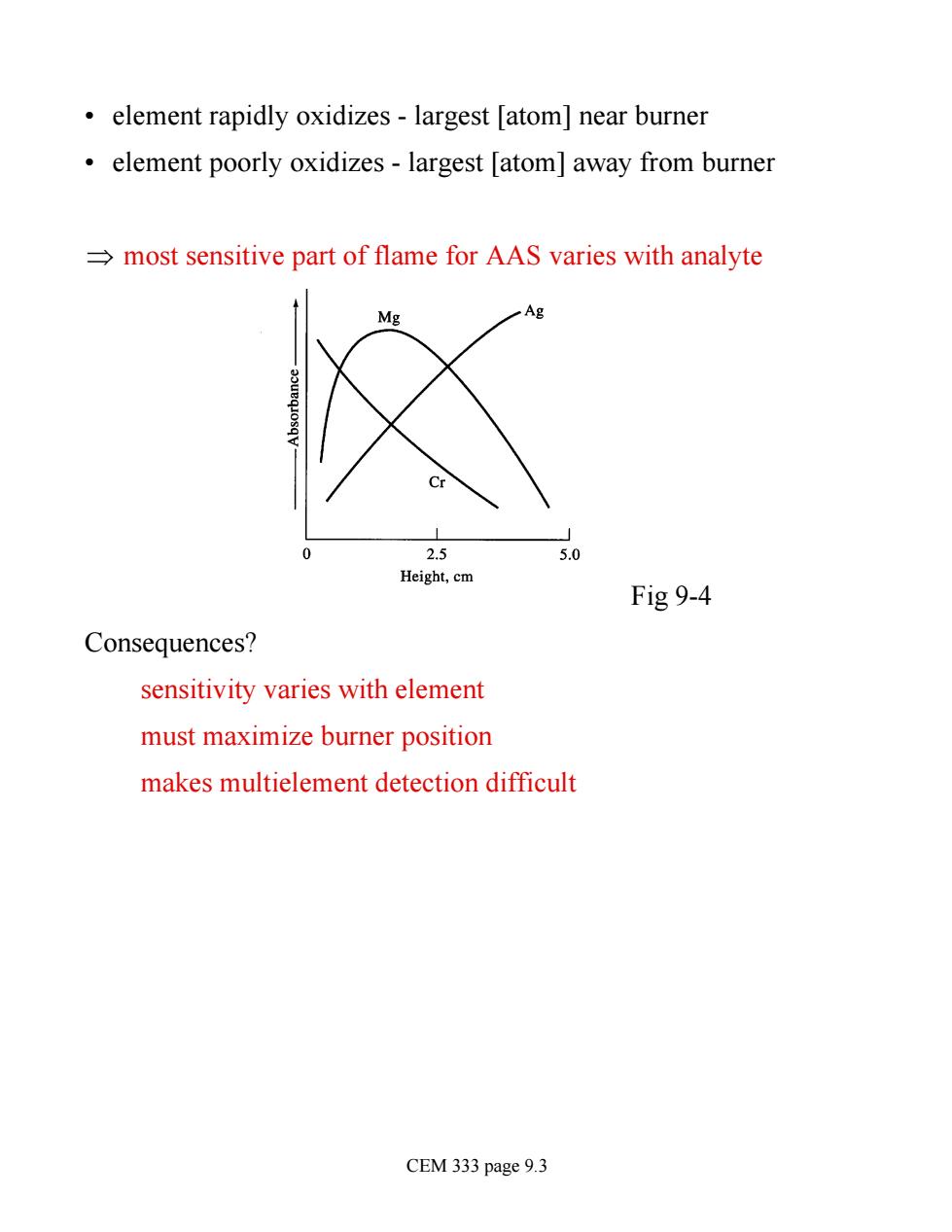
element rapidly oxidizes-largest [atom]near burner element poorly oxidizes-largest [atom]away from burner most sensitive part of flame for AAS varies with analyte 2.5 5.0 Height,cm Fig 9-4 Consequences? sensitivity varies with element must maximize burner position makes multielement detection difficult CEM 333 page 9.3
• element rapidly oxidizes - largest [atom] near burner • element poorly oxidizes - largest [atom] away from burner Þ most sensitive part of flame for AAS varies with analyte Fig 9-4 Consequences? sensitivity varies with element must maximize burner position makes multielement detection difficult CEM 333 page 9.3
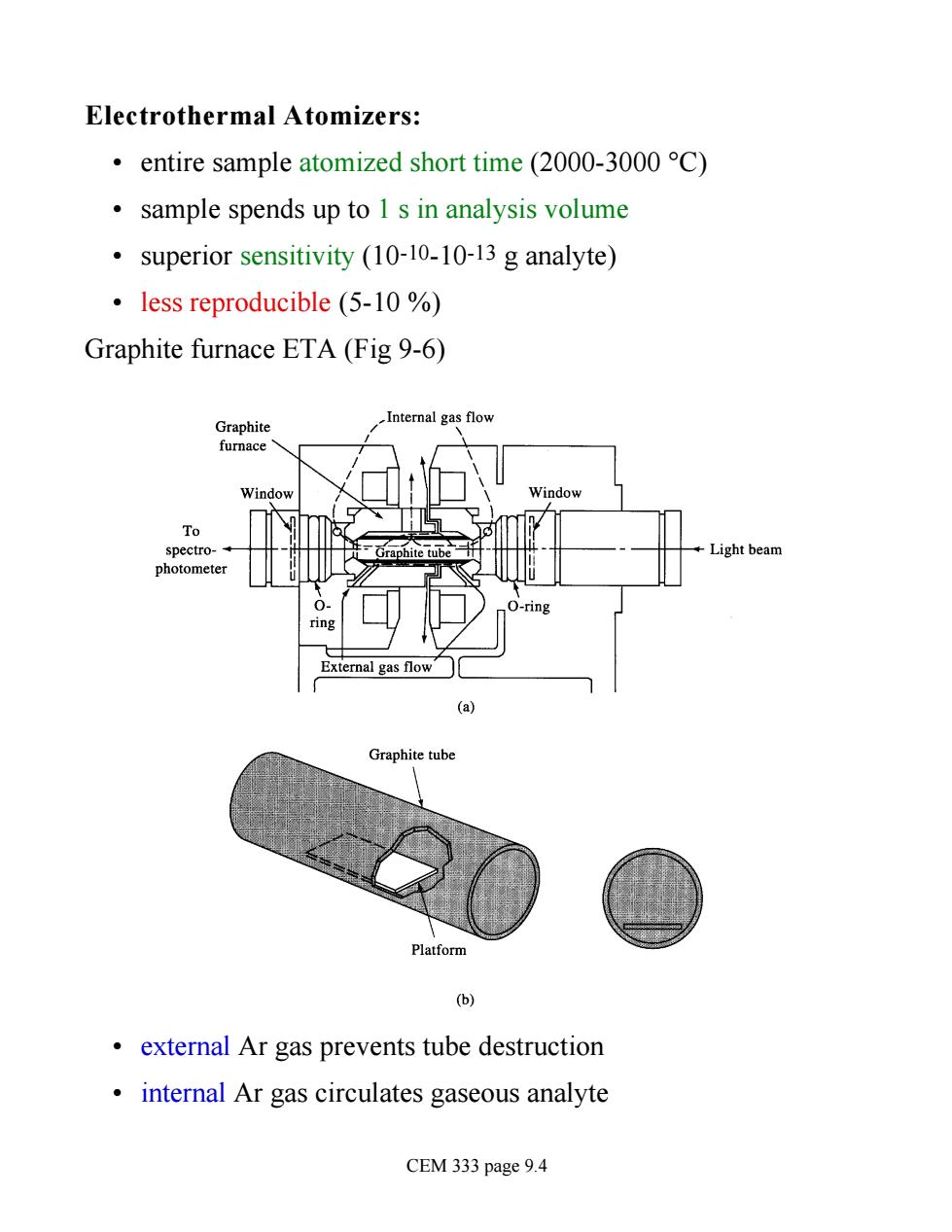
Electrothermal Atomizers: entire sample atomized short time(2000-3000 C) sample spends up to 1 s in analysis volume .superior sensitivity (10-10-10-13g analyte) less reproducible (5-10 % Graphite furnace ETA(Fig 9-6) Graphite Internal gas flow furnace indow To Light beam ring External gas flow☐ Graphite tube Platform 6 external Ar gas prevents tube destruction internal Ar gas circulates gaseous analyte CEM 333 page 9.4
Electrothermal Atomizers: • entire sample atomized short time (2000-3000 °C) • sample spends up to 1 s in analysis volume • superior sensitivity (10-10-10-13 g analyte) • less reproducible (5-10 %) Graphite furnace ETA (Fig 9-6) • external Ar gas prevents tube destruction • internal Ar gas circulates gaseous analyte CEM 333 page 9.4

Three step sample preparation for graphite furnace: (1)Dry evaporation of solvents (10->100 s) (2)Ash-removal of volatile hydroxides,sulfates, carbonates (10-100 s) (3)Fire/Atomize-atomization of remaining analyte(1 s) 0.8 0.7 0.6- 0.5 0.4 Standards(μgmL) 0.2 0.3 03 0.1 0.1 0.05 0.0 Standards Sample Fig 9-7 CEM 333 page 9.5
Three step sample preparation for graphite furnace: (1) Dry - evaporation of solvents (10->100 s) (2) Ash - removal of volatile hydroxides, sulfates, carbonates (10-100 s) (3) Fire/Atomize - atomization of remaining analyte (1 s) Fig 9-7 CEM 333 page 9.5

Atomic Absorption Instrumentation: AAS should be very selective-each element has different set of energy levels and lines very narrow BUT for linear calibration curve (Beers'Law)need bandwidth of absorbing species to be broader than that of light source difficult with ordinary monochromator Solved by using very narrow line radiation sources minimize Doppler broadening ·pressure broadening lower P and T than atomizer and using resonant absorption Na emission 3p->2s at 589.6 nm used to probe Na in analyte CEM 333 page 9.6
Atomic Absorption Instrumentation: • AAS should be very selective - each element has different set of energy levels and lines very narrow • BUT for linear calibration curve (Beers' Law) need bandwidth of absorbing species to be broader than that of light source difficult with ordinary monochromator Solved by using very narrow line radiation sources • minimize Doppler broadening • pressure broadening • lower P and T than atomizer and using resonant absorption • Na emission 3p®2s at 589.6 nm used to probe Na in analyte CEM 333 page 9.6
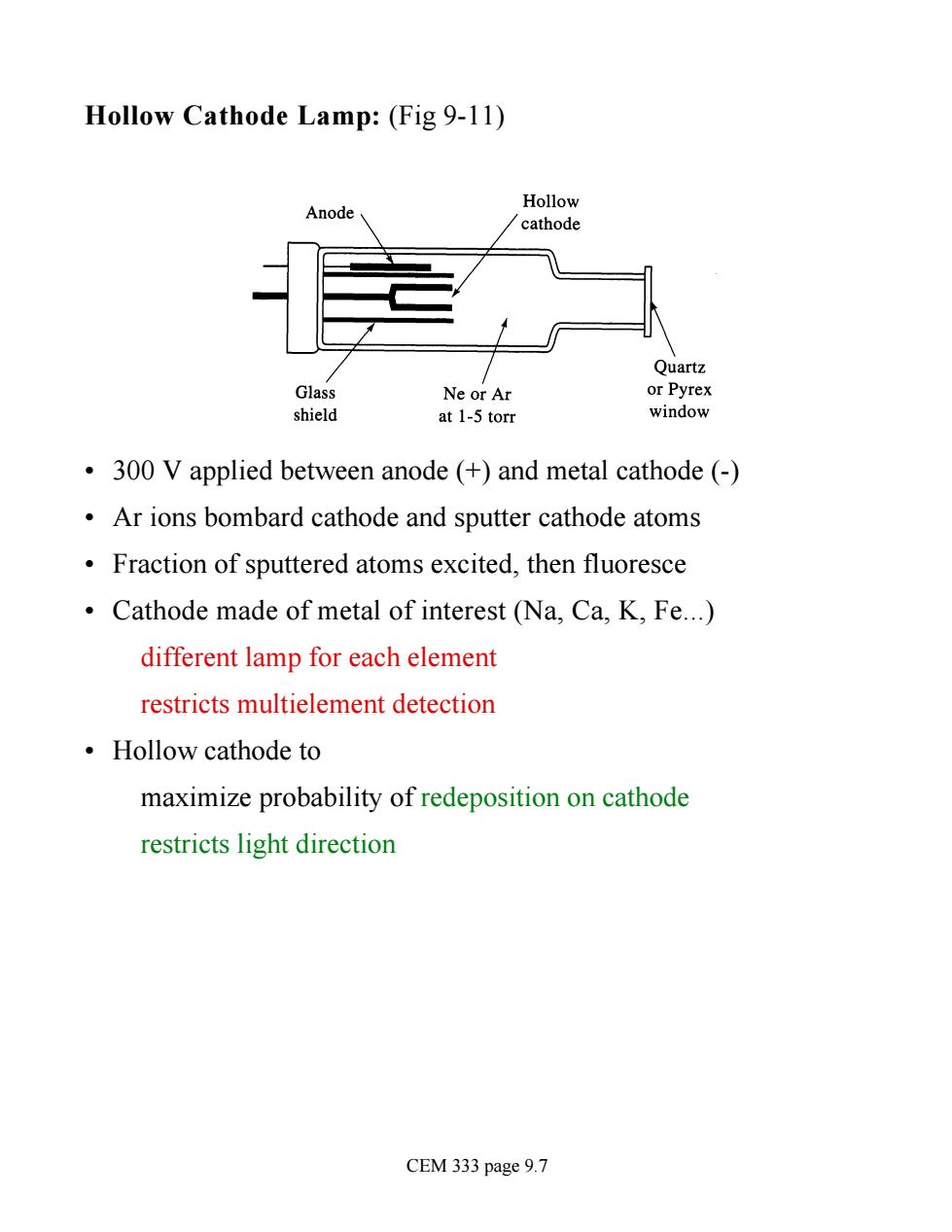
Hollow Cathode Lamp:(Fig 9-11) Hollow Anode cathode Quartz Glass shield Ne or Ar or Pyrex at 1-5 torr window 300 V applied between anode (+)and metal cathode (- Ar ions bombard cathode and sputter cathode atoms Fraction of sputtered atoms excited,then fluoresce Cathode made of metal of interest (Na,Ca,K.Fe.) different lamp for each element restricts multielement detection ·Hollow cathode to maximize probability of redeposition on cathode restricts light direction CEM 333 page 9.7
Hollow Cathode Lamp: (Fig 9-11) • 300 V applied between anode (+) and metal cathode (-) • Ar ions bombard cathode and sputter cathode atoms • Fraction of sputtered atoms excited, then fluoresce • Cathode made of metal of interest (Na, Ca, K, Fe.) different lamp for each element restricts multielement detection • Hollow cathode to maximize probability of redeposition on cathode restricts light direction CEM 333 page 9.7
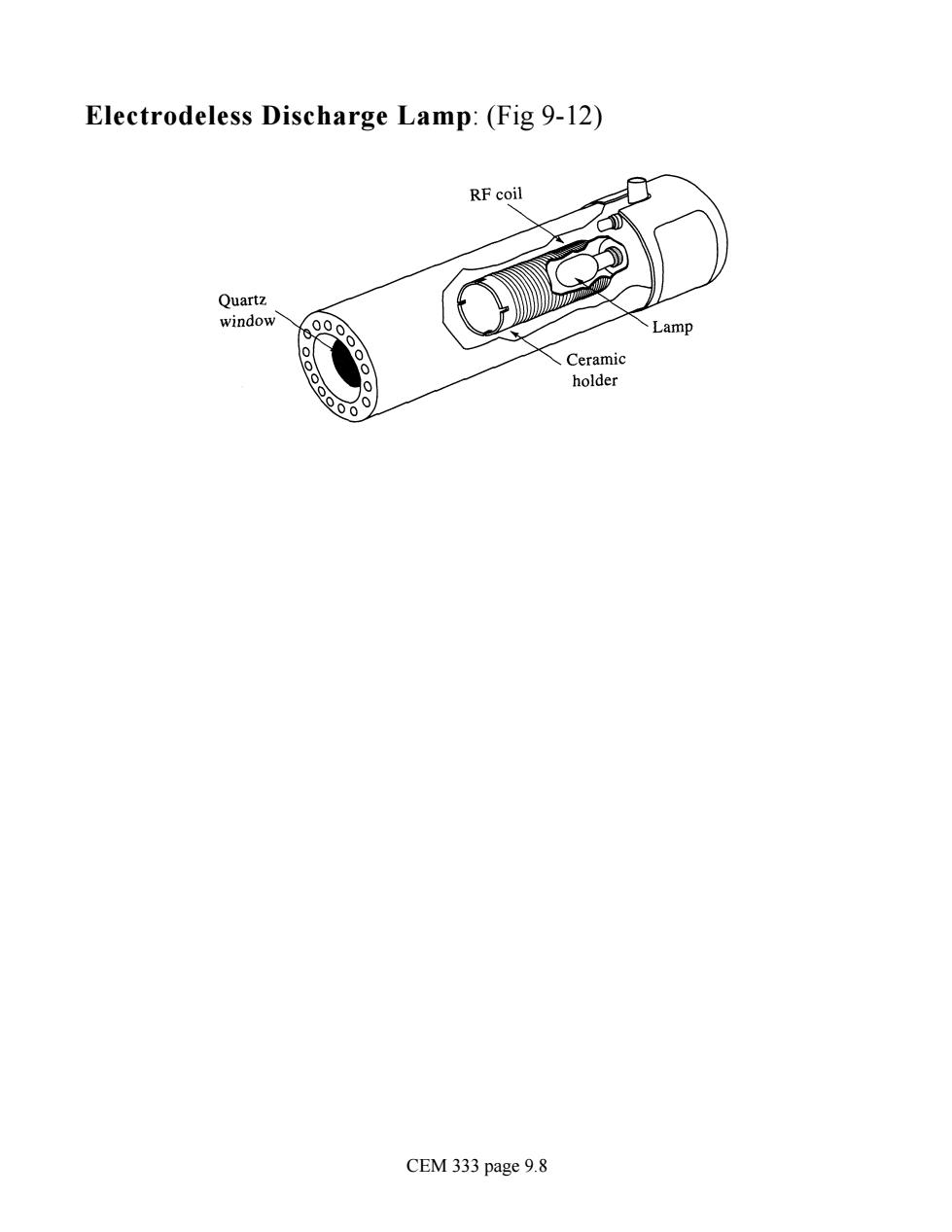
Electrodeless Discharge Lamp:(Fig 9-12) RFcoil Quartz window 00 am CEM 333 page 9.8
Electrodeless Discharge Lamp: (Fig 9-12) CEM 333 page 9.8

AAS Spectrophotometers: eadout mplifie Ebert monochromator Lamp me (a) Fig9-13(a) Signal at one wavelength often contains luminescence from interferents in flame Chemical interference: (i)reverses atomization equilibria (ii)reacts with analyte to form low volatility compound releasing agent-cations that react preferentially with interferent-Sr acts as releasing agent for Ca with phosphate protecting agent-form stable but volatile compounds with analyte(metal-EDTA formation constants) CEM 333 page 9.9
AAS Spectrophotometers: Fig 9-13(a) Signal at one wavelength often contains luminescence from interferents in flame Chemical interference: (i) reverses atomization equilibria (ii) reacts with analyte to form low volatility compound releasing agent - cations that react preferentially with interferent - Sr acts as releasing agent for Ca with phosphate protecting agent - form stable but volatile compounds with analyte (metal-EDTA formation constants) CEM 333 page 9.9
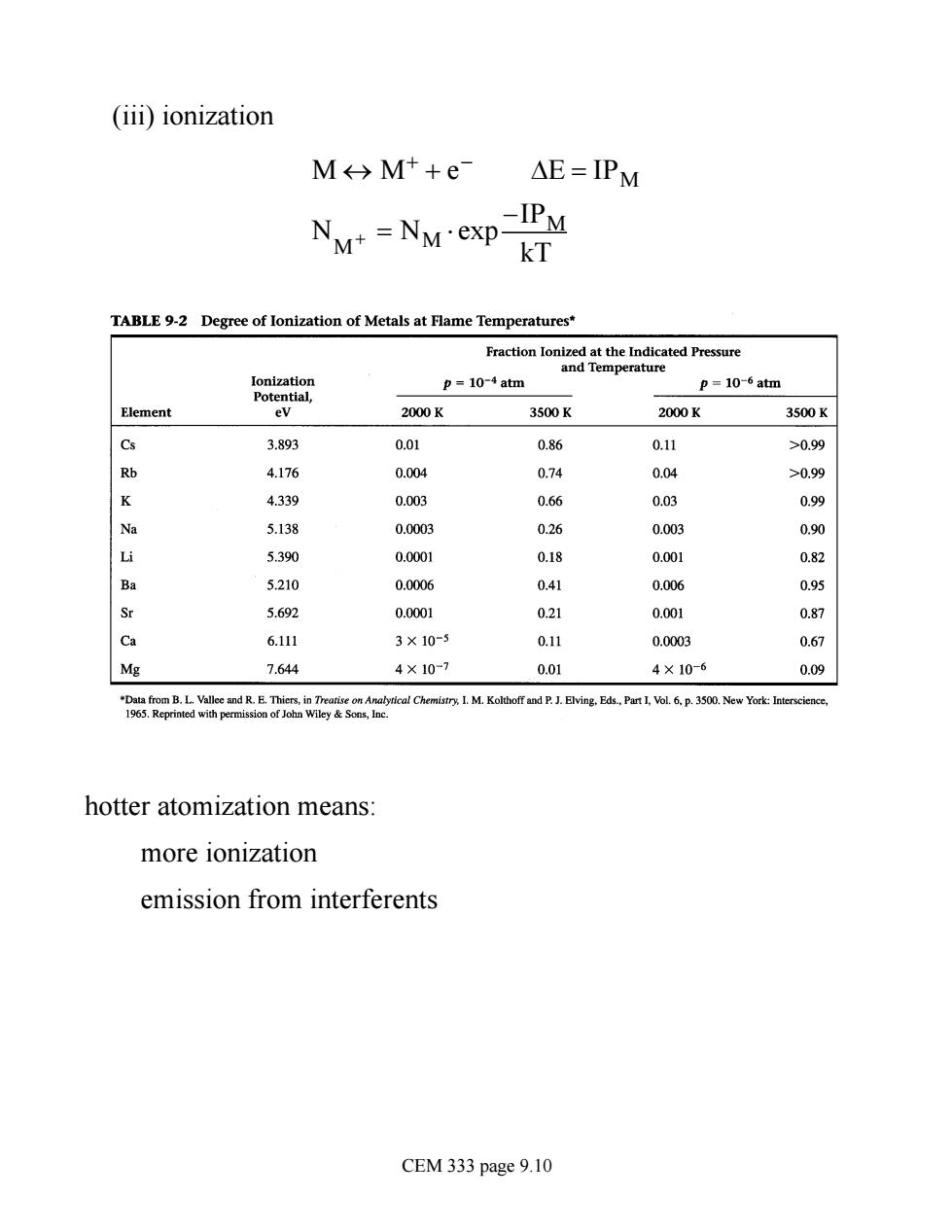
(iii))ionization M→Mt+e △E=IPM NM=NM-exp-IPM kT TABLE 92 Degree of Ionization of Metals at Flame Temperatures p=10-4atm p=10-6atm Element ev 2000K 3500K 2000K 3500K 3.893 0.01 0.86 0.11 >0.99 4.176 0.004 0.74 0.04 >0.99 K 4.339 0.003 0.66 0.03 0.99 5.138 0.0003 0.26 0.003 0.90 5.390 0.0001 0.18 .00 0.82 5.210 0.0006 0.41 0.006 0.95 Sr 5.692 0.0001 021 0.001 0.87 Ca 6.111 3×10-5 0.11 0.0003 0.67 Mg 7.644 4×10-7 0.01 4×10-6 0.09 hotter atomization means: more ionization emission from interferents CEM 333 page 9.10
(iii) ionization M « M+ + e - DE = IPM NM+ = NM × exp -IPM kT hotter atomization means: more ionization emission from interferents CEM 333 page 9.10